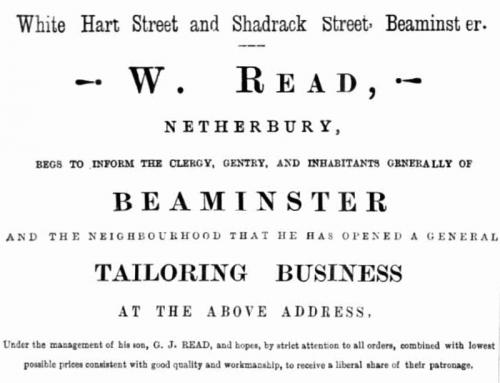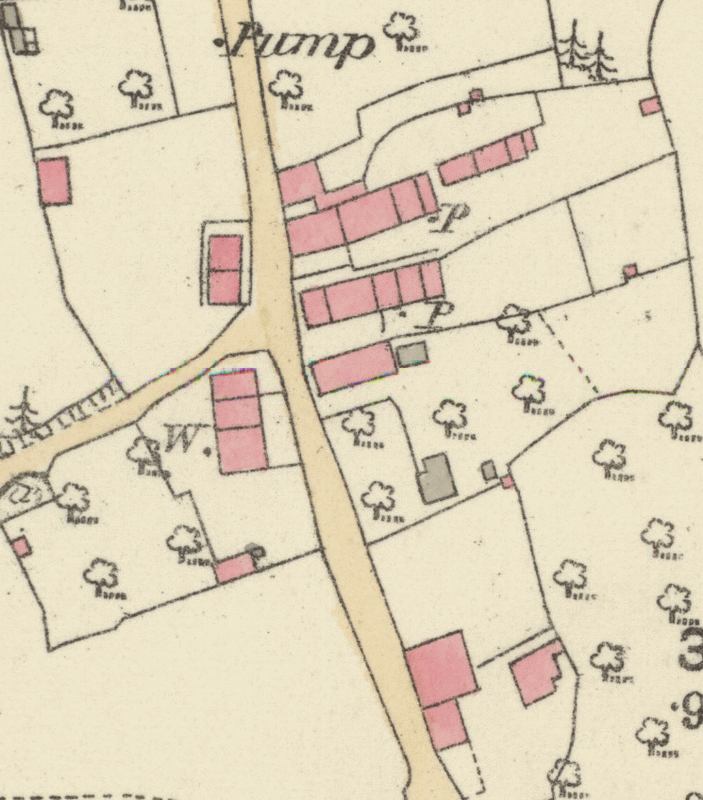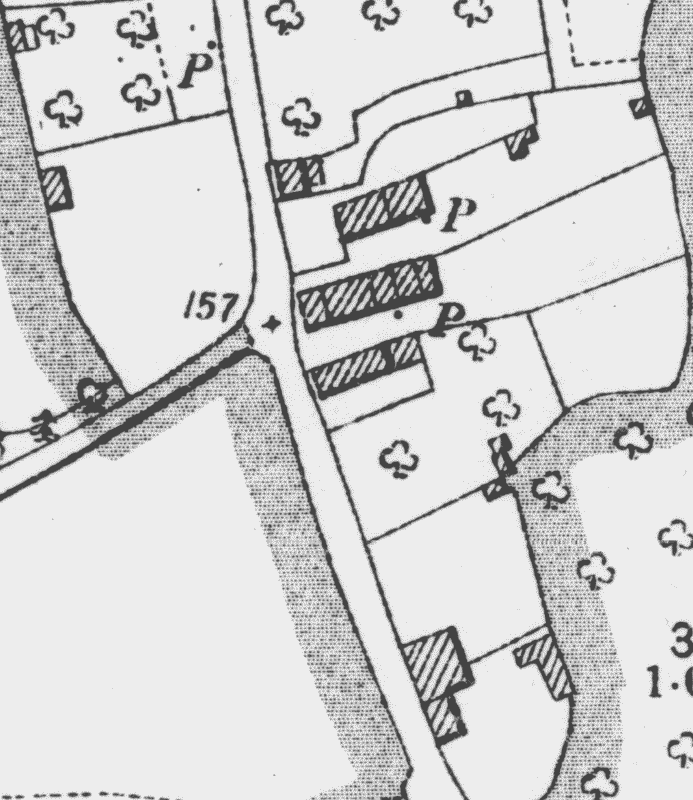It’s hard to trace what happened to the families who were burnt out and lost so many of the few things they owned. It’s pretty obvious that, in the absence of any statutory social services, the community pulled together and temporary accommodation was found but beyond that there’s little detail. A fortnight after the fire Edwin. G. Hodder, the son of Elizabeth and George the Baker, wrote a letter to the paper thanking “the many kind helpers, in numerous ways, to my parents, during the recent calamitous fire at Netherbury”.
Soon after the fire the vicar, Rev. William Gildea, set up a fund by appealing to his friends and other contacts from which the families were compensated for their losses. We know this because an article appeared in the Bridport News a couple of months later roundly praising the vicar for his efforts. Rev. Gildea was an important and influential man involved in local politics as well as the church. He served on many committees and knew lots of other important and influential people in the parish and beyond. He was no stranger to the columns of the Bridport News with his name appearing somewhere in the paper most weeks between 1880 and 1900.
Unfortunately the distribution of the fund seems to have led to some bad feeling and a rather public spat playing out in the correspondence sections of the Bridport News. An anonymous letter appeared complaining that “Mr. Hodder, has not received any of the collected help”. The writer also suggests that Hodder suffered some pilfering of his belongings which had been rescued from the fire. There is a hint of some sort of pre-existing animosity when the correspondent says “I do think, the Vicar might have at least offered Mr Hodder (to show their was no ill-feeling) a share even if he declined to accept.”
The vicar doesn’t turn the other cheek and a week later a barbed riposte was published. He starts by questioning whether Mr Hodder was aware of the anonymous letter and suggests “If he is not ashamed of it, I think that every respectable person in the village of Netherbury feels that he ought to be”. He states that the funds were raised to compensate the uninsured and that Mr Hodder was never considered as a beneficiary because he had cover.
It’s been impossible to find exactly where George Hodder relocated to in the immediate aftermath of the fire but and advertisement appeared in the Bridport News of June 10th, 1892 asking for tenders to be submitted to rebuild the house (now Virginia Cottage).

Bridport News. Friday, June 10, 1892
George Hodder is listed as a Baker in the entry for Netherbury in the 1895 Kelly’s Directory.
Elizabeth Hodder died four years after the fire on 26th March, 1896 and was buried at Chetnole, where she was born, on 1st April.
By the 1901 census George is listed as a Retired Baker, living with his eldest son, Edwin, now a Headmaster (having been a pupil teacher in Netherbury from 1880 to 1884) and Daughter-in-law, Julia, at Much Hadham, Hertfordshire. However, he’s included in 1901 Register of Electors for Netherbury but the “address” is only shown as The Village.
He died at Much Hadham on 8 May, 1924.
There isn’t much detail either about what happened to George Watts and his family, in whose chimney the fire started. The anonymous letter to the Bridport News states they were the first to be rehoused and from the vicar’s reply we can glean that they moved to a property owned by Mr. Tucker, the parish churchwarden. The 1901 census shows the Watts family living at Bridge Mead Cottage, Netherbury and in the 1911 census their address is just listed as The Village.
About three months after the fire an advert appeared in the Bridport News:
![]()
There are no further details but there are only two G. Watts listed in the 1891 census – George being one and the other is George H. Watts, his 15 year old son.
Amongst the Watts’ neighbours in their row of tenementRented dwelling
or lands Frederick & Louisa Norris seem to have taken on a pub in North Allington called The Gardeners Arms (now The Oddfellows Arms). The Bridport News has a report (July 24, 1896) of a trial at which they were accused of selling intoxicating liquor during prohibited hours. The charge was dismissed.
John H Hawker, his wife and four children also moved to Allington and are listed in the 1901 census as living at 4 Sunny Bank, Allington, Bridport with John still working as a Carriage Painter. Sunnybank is now a Grade II listed building “rebuilt in 1884” just off Mount Pleasant.
The 1901 census lists Thomas Travers, now a Roadman, his wife and a boarder as living in Whitecross.
James Budden, described as “an invalid” in the Bridport News and “Formerly Millers Carter” in the census a year before died just over a year after the fire and was buried in Netherbury on 2nd May, aged 42. His last son, William, was baptised a couple of months later. His wife Annie (née Spurdle) had another child, Minnie (23rd September, 1895) when, according to the baptism register, she was living in the Union Workhouse. Then, on 20th December 1895, she married William Tolley from over the road, who was also burnt out.
Tolley had been widowed himself 3½ years before the fire. He was probably the father of Annie’s daughter Minnie although he wasn’t named in the baptism register. After they were married they went on to have seven more children before he died in October 1909. The 1901 census shows them living in Whitecross. Between them William and Annie had a total of 17 children. In 1911 the census records Annie as living with five of her children (including William Budden) but the address is only recorded as Netherbury.
The only other victim of the fire named by the Bridport News was Charles Watts who was rescued from probable asphyxiation by William Read, he died on 27th December that year aged 71. No details remain to indicate if his death was linked to his experience of the fire. He was buried in Netherbury on 2nd January, 1893.
The Bridport News said that there were “nine tenementRented dwelling
or lands occupied and four untenanted” but only identified eight families as being “burnt out” which may be because George Hodder was occupying two, one as a bakery.
Two of the four untenanted properties were to the north of the corner of Hingsdon Lane and St James Rd where 2 & 3 Pyes Plot stand now. Looking at old maps it would appear that there may have been a third one alongside Charles Watts’ & William Tolley's’ houses to the south of the junction and probably one unoccupied in the row where the fire started.
The day after the fire there was an auction advertised in the Bridport News to sell the plot of Garden Ground that is now Pyes Plot. This tells us the cottages must have already been “ruins” before the fire. The advertisement appeared unchanged for the three weeks prior to the auction.
On Tuesday, 19th April 1892, Mr Samuel Cox will offer for sale by public auction, at the White Hart Hotel, Beaminster, at 3 o’clock p.m. precisely (subject to Conditions of Sale to be then read) the undermentioned valuable properties
Lot: 2
Description: A Plot of Garden Ground, with the ruins of 3 Cottages thereon, situate in the village of Netherbury at the corner of Hingsdon Lane… Immediate possession of this Lot may be had.
No. on Tithe Map: 1367, 1368
Quantity: 1 rood, 13 perches
William Read, whose house was not burnt despite being positioned in the middle of the conflagration, was able to proceed with plans to expand his tailoring business, opening another shop in Beaminster.

Bridport News. Friday, June 10, 1892
It would appear that some of the burnt out buildings were demolished rather than rebuilt. We’re lucky that there were two very detailed maps published by the Ordnance Survey around this time. The original survey was done before the fire and that was revised for the second map.
You can see from the comparison that much of the row where the fire started was still missing in 1901 as well as all the houses on the western side of St James Rd.
 |
 |
|||
| Surveyed in 1888 | Revised in 1901 |

